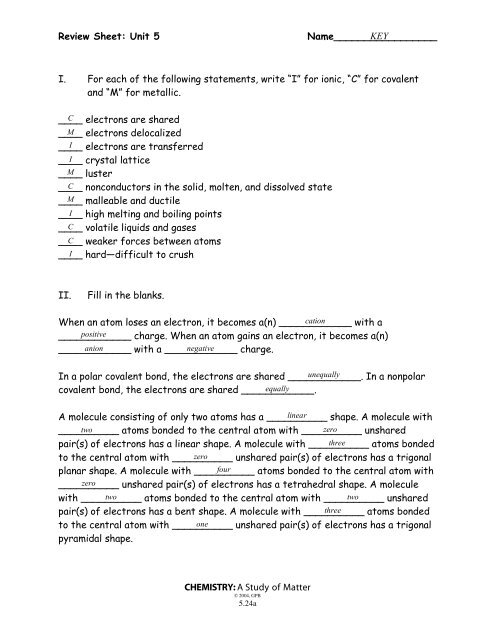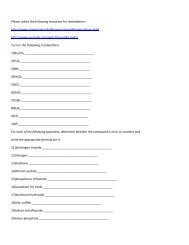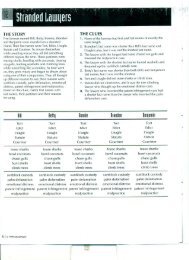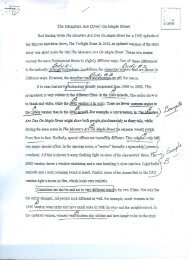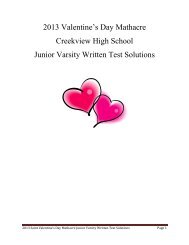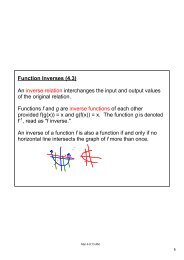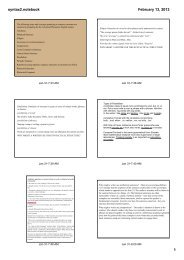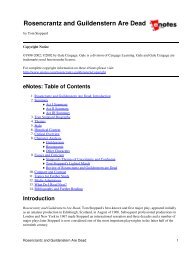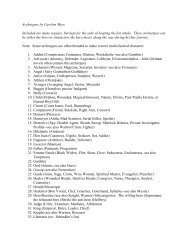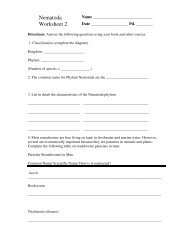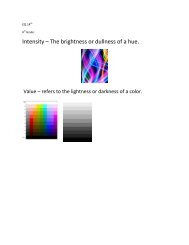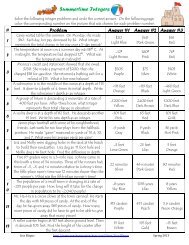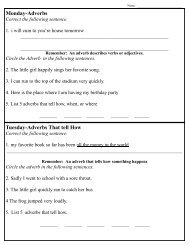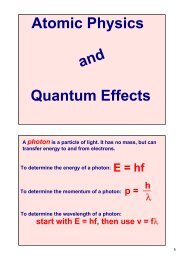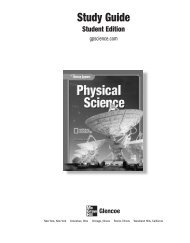You also want an ePaper? Increase the reach of your titles
YUMPU automatically turns print PDFs into web optimized ePapers that Google loves.
Review Sheet: Unit 5 Name_________________<br />
KEY<br />
I. For each of the following statements, write “I” for ionic, “C” for covalent<br />
and “M” for metallic.<br />
C<br />
____ electrons are shared<br />
____ M electrons delocalized<br />
____ I electrons are transferred<br />
____ I crystal lattice<br />
____ M luster<br />
____ C nonconductors in the solid, molten, and dissolved state<br />
____ M malleable and ductile<br />
____ I high melting and boiling points<br />
____ C volatile liquids and gases<br />
____ C weaker forces between atoms<br />
____ I hard—difficult to crush<br />
II. Fill in the blanks.<br />
When an atom loses an electron, it becomes a(n) ____________ with a<br />
____________ positive charge. When an atom gains an electron, it becomes a(n)<br />
____________ anion with a ____________ negative charge.<br />
In a polar covalent bond, the electrons are shared ____________. In a nonpolar<br />
covalent bond, the electrons are shared ____________.<br />
equally<br />
linear<br />
A molecule consisting of only two atoms has a __________ shape. A molecule with<br />
__________ two atoms bonded to the central atom with __________ zero unshared<br />
pair(s) of electrons has a linear shape. A molecule with __________ three atoms bonded<br />
to the central atom with __________ zero unshared pair(s) of electrons has a trigonal<br />
planar shape. A molecule with __________ four atoms bonded to the central atom with<br />
__________ zero unshared pair(s) of electrons has a tetrahedral shape. A molecule<br />
with __________ two atoms bonded to the central atom with __________ two unshared<br />
pair(s) of electrons has a bent shape. A molecule with __________ three atoms bonded<br />
to the central atom with __________ one<br />
unshared pair(s) of electrons has a trigonal<br />
pyramidal shape.<br />
CHEMISTRY: A Study of Matter<br />
© 2004, GPB<br />
5.24a<br />
cation<br />
unequally
While bonding is the force of attraction WITHIN molecules,<br />
________________________ intermolecular forces are the forces of attraction BETWEEN molecules.<br />
The force present in all molecules that results from the movement of electrons is<br />
called _____________________________________. London-dispersion forces<br />
The force of attraction<br />
between the positive end of one molecule and the negative end of another molecule<br />
is ________________________. dipole-dipole<br />
The special type of this force involving<br />
hydrogen is called ________________________. hydrogen bonding<br />
This occurs when hydrogen is<br />
bonded to ________________, fluorine ________________, oxygen or ________________.<br />
nitrogen<br />
III. What type of bond will form between the following pairs of atoms?<br />
Na and F N and O I and I<br />
4.0 – 0.9 = 3.1<br />
ionic<br />
Fe and Cl Br and I Ca and O<br />
3.0 – 1.8 = 1.2<br />
polar covalent<br />
3.5 – 3.0 = 0.5<br />
polar covalent<br />
2.8 – 2.5 = 0.3<br />
nonpolar covalent<br />
IV. Draw Electron Dot Diagrams for the following elements.<br />
magnesium iodine boron<br />
•<br />
Mg •<br />
• •<br />
•<br />
• I •<br />
sulfur carbon krypton<br />
• •<br />
•<br />
• S •<br />
•<br />
• •<br />
•<br />
• C •<br />
•<br />
CHEMISTRY: A Study of Matter<br />
© 2004, GPB<br />
5.24b<br />
•<br />
B •<br />
•<br />
•<br />
• •<br />
• •<br />
Kr •<br />
• •<br />
2.5 – 2.5 = 0.0<br />
nonpolar covalent<br />
3.5 – 1.0 = 2.5<br />
ionic
V. Draw Lewis Structures for the following molecules and polyatomic ions.<br />
PCl3 CH4<br />
• •<br />
• Cl<br />
•<br />
• •<br />
• •<br />
! P<br />
|<br />
• •<br />
Cl • •<br />
• •<br />
• •<br />
•<br />
! Cl •<br />
• •<br />
ClO2 1- NH2Cl<br />
• • " •<br />
$ O •<br />
# • •<br />
• •<br />
! Cl<br />
• •<br />
• • % •<br />
O • '<br />
• • &<br />
ONCl OH 1-<br />
•<br />
• •<br />
•<br />
O<br />
• •<br />
= N<br />
• •<br />
•<br />
Cl •<br />
• •<br />
SO3 2- SO3<br />
• • " •<br />
$ O •<br />
$ • •<br />
$<br />
$<br />
# $<br />
• •<br />
! S<br />
|<br />
• •<br />
O • •<br />
• •<br />
C2H2 IBr<br />
NO2 1- SiO2<br />
!<br />
#<br />
"<br />
1!<br />
2!<br />
• • % •<br />
! O • '<br />
• • '<br />
'<br />
'<br />
&'<br />
H ! C " C ! H<br />
• •<br />
•<br />
O •<br />
• •<br />
= N<br />
1' • • $ •<br />
O • &<br />
• • %<br />
•<br />
• •<br />
•<br />
O<br />
CHEMISTRY: A Study of Matter<br />
© 2004, GPB<br />
5.24c<br />
H<br />
|<br />
H ! C ! H<br />
|<br />
H<br />
• •<br />
H ! N<br />
|<br />
• •<br />
Cl • •<br />
• •<br />
• • " •<br />
$ O ! H<br />
•<br />
# • •<br />
• •<br />
•<br />
O •<br />
• •<br />
• I<br />
•<br />
• •<br />
! H<br />
%<br />
'<br />
&<br />
1!<br />
• •<br />
= S !<br />
•<br />
O •<br />
|<br />
• •<br />
• •<br />
O • •<br />
• •<br />
• •<br />
•<br />
! Br •<br />
• •<br />
= Si =<br />
• •<br />
•<br />
O •
VI. Predict the shape each of the following molecules will form. (Hint: see<br />
previous page for Lewis Structures.)<br />
PCl3 CH4<br />
NH2Cl trigonal pyramidal SiO2<br />
SO3<br />
trigonal planar<br />
C2H2<br />
IBr<br />
trigonal pyramidal<br />
linear<br />
VII. Draw the Lewis Structure for H2O. Predict the bond type. Label any<br />
partially positive or negative ends. Determine whether a molecule of water is<br />
polar or nonpolar and explain your answer.<br />
3.5 – 2.1 = 1.4<br />
polar covalent bonds<br />
Draw the Lewis Structure for SiCl4. Predict the bond type. Label any<br />
partially positive or negative ends. Determine whether a molecule of SiCl4 is<br />
polar or nonpolar and explain your answer.<br />
3.0 – 1.8 = 1.2<br />
polar covalent bonds<br />
! +<br />
! "<br />
• •<br />
! "<br />
•<br />
H " O •<br />
|<br />
• •<br />
• Cl<br />
•<br />
• •<br />
H ! +<br />
• •<br />
! "<br />
• •<br />
Cl • •<br />
|<br />
" Si<br />
|<br />
VIII. Circle the intermolecular forces in the following diagram.<br />
! +<br />
• •<br />
Cl • •<br />
• • ! "<br />
H O H O H O<br />
• •<br />
•<br />
" Cl •<br />
• •<br />
H H H<br />
H O H O<br />
! "<br />
H H<br />
CHEMISTRY: A Study of Matter<br />
© 2004, GPB<br />
5.24d<br />
tetrahedral<br />
linear<br />
linear<br />
The water molecule will have a bent shape because<br />
it has 2 atoms bonded to the central atom with 2<br />
unshared pairs of electrons.<br />
This will put the partially positive hydrogens on one<br />
end and the partially negative oxygen on the other,<br />
so the molecule is POLAR.<br />
The molecule will have a tetrahedral shape<br />
because it has 4 atoms bonded to the central<br />
atom with no unshared pairs of electrons. This<br />
will not allow for a positive and negative end,<br />
so the molecule is NONPOLAR.


